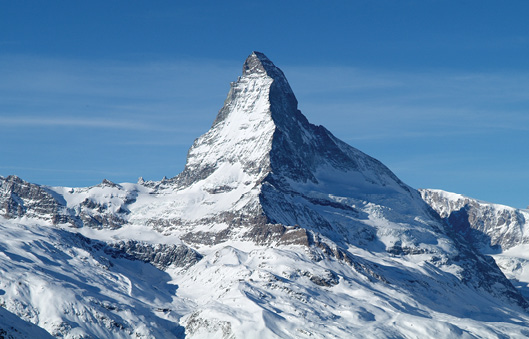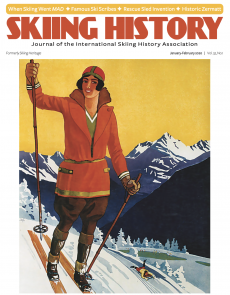
SKIING HISTORY
Editor Kathleen James
Art Director Edna Baker
Contributing Editor Greg Ditrinco
ISHA Website Editor Seth Masia
Editorial Board
John Fry, Seth Masia, John Allen, John Caldwell, Jeremy Davis, Kirby Gilbert, Paul Hooge, Jeff Leich, Bob Soden, Ingrid Wicken
Founding Editors
Morten Lund, Glenn Parkinson
To preserve skiing history and to increase awareness of the sport’s heritage
ISHA Founder
Mason Beekley, 1927–2001
ISHA Board of Directors
John Fry, Chairman
Seth Masia, President
Wini Jones, Vice President
Jeff Blumenfeld, Vice President
John McMurtry, Vice President
Chan Morgan, Treasurer
Einar Sunde, Secretary
Richard Allen, Skip Beitzel, Michael Calderone, Christin Cooper, Art Currier, Dick Cutler, Chris Diamond, Mike Hundert, David Ingemie, Rick Moulton, Wilbur Rice, Charles Sanders, Bob Soden (Canada), Betty Tung
Presidential Circle
Christin Cooper, Billy Kidd, Jean-Claude Killy, Bode Miller, Doug Pfeiffer, Penny Pitou, Nancy Greene Raine
Business & Events Manager
Kathe Dillmann
P.O. Box 1064
Manchester Center VT 05255
(802) 362-1667
kathe@skiinghistory.org
Membership Services
Laurie Glover
(802) 375-1105
laurie@skiinghistory.org
Corporate Sponsorships
Peter Kirkpatrick
(541) 944-3095
peterk10950@gmail.com
Skiing History (USPS No. 16-201, ISSN: 23293659) is published bimonthly by the International Skiing History Association, P.O. Box 1064, Manchester Center, VT 05255.
Periodicals postage paid at Manchester Center, VT and at additional mailing offices. Postmaster: Send address changes to ISHA, P.O. Box 1064, Manchester Center, VT 05255
ISHA is a 501(c)(3) public charity. EIN: 06-1347398
Written permission from the editor is required to reproduce, in any manner, the contents of Skiing History or skiinghistory.org, either in full or in part.
Resorts Then and Now: Zermatt, Rising Above it All
The history of skiing in Zermatt is inextricably linked to the mighty Matterhorn.
By Everett Potter
Is there a more perfect ski resort than Zermatt? Set in a picturesque mountain valley at the base of the Matterhorn, this car-free Swiss village is surrounded by 38 summits above 4,000 meters, offering nearly 125 miles of pistes. It’s linked by lifts and trails to Cervinia in Italy, with another 100 miles of runs.
In winter, Zermatt’s population swells from 5,700 to 40,000. Skiers from all over the world stay in its low-rise chalets and elegant century-old hotels, shop in high-end boutiques, dine on traditional fondue and Michelin-starred fare, and raise an après-ski glass at dozens of bars both on and off the mountain. And rising above it all is the Matterhorn, a pyramid-shaped outcropping of rock that’s hypnotic and dramatic. Zermatt’s ski history is inextricably linked to this iconic mountain, arguably the most photographed in the world.
Photo at top of page: The iconic Matterhorn rises above the village of Zermatt on the Swiss-Italian border. Its 14,692-foot summit was first conquered in 1865 by the British climber Edward Whymper. Kurt Muller photo.
During the mountaineering craze that seized Europe in the late 18th century, many peaks in the Alps were successfully summited, including Mont Blanc in 1786. But the Matterhorn remained stubbornly unconquered until 1865. That’s when a single-minded British printer named Edward Whymper finally made it to the top after seven previous attempts, only to lose four of his climbing party on the descent when a rope broke. That tragedy, which still resonates today when the Matterhorn is discussed in Zermatt—the Swiss and the English are remarkably quick to take sides—gave the mountain town even more cachet. More climbers followed and so did tourists, determined to see the magical peak for themselves. The British upper classes led the way, followed by the middle-class masses, traveling with Thomas Cook on organized tours that gave birth to today’s modern tourism industry.
 Right: After seven previous attempts, Whymper finally made it to the top, only to lose four of his climbing party on the descent when a rope broke. The triumph and the tragedy, which still resonates in Zermatt today, gave the mountain town even more cachet with British tourists of the time. Photo: Zermatt Tourism
Right: After seven previous attempts, Whymper finally made it to the top, only to lose four of his climbing party on the descent when a rope broke. The triumph and the tragedy, which still resonates in Zermatt today, gave the mountain town even more cachet with British tourists of the time. Photo: Zermatt Tourism
At first, they came by horse and carriage, or rode on donkeys, up the long valley that leads from the town of Visp. The opening of the Visp-Zermatt railway in 1891, followed by the opening of the Gornergrat Railway in 1898, the first electric railway in Switzerland, helped to bring many more summer tourists. They stayed at such newly opened hotels as the Riffelalp, the Zermatterhof and the Mont Cervin, which to this day are the leading five-star hotels in Zermatt, as well as the four-star Monte Rosa in the heart of the town.
This hotel empire was begun by Alexander Seiler in 1853, when he leased a small chalet that would later become the Monte Rosa. He took over the newly built Mont Cervin, and then built the Riffelberg mountain guest house. At 8,740 feet above sea level, it was Europe’s highest guest house at the time. It stands to this day and was where Mark Twain stayed in the 1870s on the trip that would result in A Tramp Abroad.
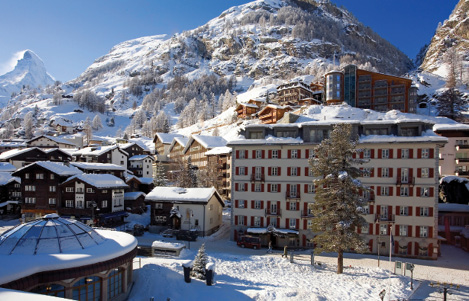 Left: Alexander Seiler started his hotel empire in 1853 with the leasing of a small chalet that would later become the four-star Monte Rosa. Over the next several decades, he acquired or built several more of Zermatt’s most famous hotels. Photo Seiler Hotels
Left: Alexander Seiler started his hotel empire in 1853 with the leasing of a small chalet that would later become the four-star Monte Rosa. Over the next several decades, he acquired or built several more of Zermatt’s most famous hotels. Photo Seiler Hotels
Seiler would go on to acquire the Zermatterhof, the Hôtel des Alpes and then build the Riffelalp on a mountainside in 1884, with a rail link and panoramic view of the Matterhorn. A Zermatt newspaper in the late 19th century said that “the large estates in the Upper Valais are owned by two parties: the nuns and Seiler.”
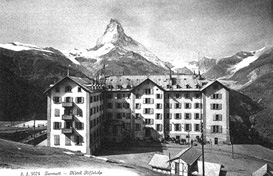 Right: Seiler built the Riffelalp on a mountainside in 1883, with a rail link and a panoramic view of the Matterhorn. Today’s glamorous hotel was built on its original foundation.
Right: Seiler built the Riffelalp on a mountainside in 1883, with a rail link and a panoramic view of the Matterhorn. Today’s glamorous hotel was built on its original foundation.
At the Riffelalp today, you see the glamorous five-star hotel built on the foundation of the original and also get a taste of local history by visiting the nearby stone chapel, built by and for the mighty Seiler family. It’s an elegant little mountain church with a bell tower and choir loft, as well as religious statues and plaques commemorating various family members.
Despite the hotels and rail lines, Zermatt then was strictly a summer destination. To keep the railway line running would have required building avalanche sheds to protect the rails from winter snows. The management company refused to make that investment, since they were already making plenty of money in the lucrative summer months.
In 1927, Seiler’s son, Hermann, opened the Victoria Hotel and winter tourism was born in Zermatt. The story goes that 180 Brits arrived in the town of St. Niklaus, about halfway up the rail line between Visp and Zermatt, and were then transported by sleighs up the valley to Zermatt. The success of that first winter convinced the federal government and the Canton of Valais to pay for avalanche sheds for the railway. In the winter of 1928–1929, limited service was offered on the Visp-Zermatt train line as well as on the Gornergrat.
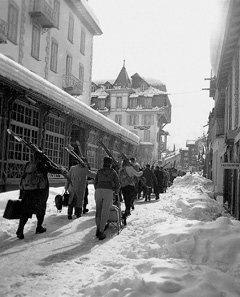
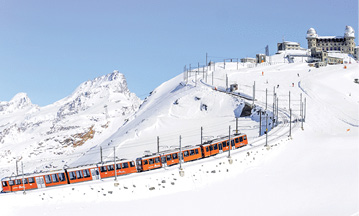 Left: Tourists tote their skis up the snow-covered Banhofstrasse. Right: A train climbs from Zermatt to the summit of the Gornergrat and its high-alpine hotel. Photo David Bumann/Zermatt Tourism
Left: Tourists tote their skis up the snow-covered Banhofstrasse. Right: A train climbs from Zermatt to the summit of the Gornergrat and its high-alpine hotel. Photo David Bumann/Zermatt Tourism
In 1932, the Swiss ski championships were held in Zermatt, but the first ski lift was not constructed until a decade later. The resort was barely a winter destination, severely lagging behind both St. Moritz and Davos by some 60 years. Winter sports in Zermatt caught on, however, and by 1944, even in the midst of the war, Zermatt in neutral Switzerland already had more winter than summer guests.
On the other side of the Matterhorn, which Italians call Monte Cervino, the Breuil ski resort opened in 1936. Benito Mussolini decreed that the name should be changed to Cervinia to reflect the Italianate glory of the mountain (and to Italianize a Germanic name).
The real growth in Zermatt commenced after World War II, in 1945, when local families whose names adorn many of the smaller hotels and guesthouses, such as Perren, Biner and Julen, got into the hotel and ski business in earnest.
The Zermatt railways had been funded by outside investors and now Zermatters wanted to keep the investment as local as possible. A classic example was when Severin Julen, a farmer, and his ski instructor son managed to finance a single ski lift with backers from Zermatt families. It took them nearly a decade to raise the funds, but in 1957 they unveiled a single seat chair that ran from Findeln to Sunnega. Other enterprising families followed suit, and it led to the rapid expansion of Zermatt’s lift system. In 1969, a gondola was proposed to reach Klein Matterhorn, at 12,740 feet. It took 10 years before the project was able to satisfy environmental and political concerns and only opened in 1979, replaced just last year by a high-speed gondola.
In 2003, five lift companies fused into a single firm, Zermatt Bergbahnen AG, and Ecosign Mountain Resort Planners completed a 20-year master plan. That kicked off a long-term rebuild that, to date, has seen CHF 500 million invested in lifts, pistes and snowmaking.
Zermatt developed as a summer ski destination in the 1960s, with eight lifts taking skiers to the Theodul Glacier. It’s still common to see members of the Swiss ski team heading up the lifts in July and August, skiing, alas, on an ever-diminishing patch of snow.
Zermatt is also the starting point for the grueling Patrouille des Glaciers, over the Valais Alps to Verbier. Now held every second year, the event dates back to 1943 as an endurance exercise for mountain troops. Three-person teams deal with an elevation gain of more than 13,000 feet and an effective distance of about 68 miles. The next one starts on April 27, 2020.
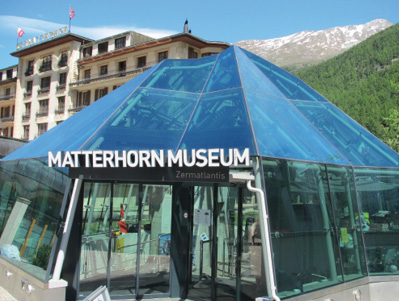 Installed underground, the Matterhorn Museum includes a recreated 19th century village, vintage skis and Whymper’s broken climbing rope.
Installed underground, the Matterhorn Museum includes a recreated 19th century village, vintage skis and Whymper’s broken climbing rope.
While ski culture thrives in Zermatt, it’s deeply intertwined with that of alpinism. The excellent Matterhorn Museum, which has been installed underground in a space where a short-lived casino once existed, has recreated a 19th century village of Zermatt, with vintage homes, vintage skis and exhibits that include a piece of Whymper’s rope. The museum’s theater has endless screenings of a truncated version of Der Berg Ruft (The Mountain Calls) by Tyrolean filmmaker Luis Trenker. The drama about Whymper’s legendary Matterhorn ascent was filmed in Zermatt in 1937–1938, and Trenker cut his cinematic teeth by working with director Arnold Fanck in 1921 on one of his early mountain films.
Adjacent to the museum is Zermatt’s Catholic Church, and behind it are the many graves of climbers who perished while attempting to climb the Matterhorn. The so-called English Church is even more atmospheric and is set on a hillside a short walk off the Bahnhofstrasse, the main street. It’s ringed by the gravestones of British mountaineers, and inside are memorials to those who perished in the late 19th and early 20th century while attempting to scale the Matterhorn.
It’s easy to feel the lure of the mountains here in summer, when the Matterhorn climbing season is in swing; more than 2,000 people attempt the climb each year. In winter, the appeal of the slopes infuses the town with a buoyant spirit. While Zermatt may not have played a role in pioneering the sport, its singular position as a center of alpinism, its dramatic beauty and its embrace of ski culture has made it Europe’s most beloved resort. 
Everett Potter is a frequent contributor to Skiing History and the editor of Everett Potter’s Travel Report (everettpotter.com).
This article originally appeared in the January-February 2020 issue of SkiingHistory.
.jpg)
Table of Contents
2020 Corporate Sponsors

World Championship
($3,000 and up)
Alyeska Resort
Gorsuch
Intuition Sports, Inc.
Obermeyer
Polartec
Warren and Laurie Miller
Snowsports Merchandising Corporation
World Cup ($1,000)
Active Interest Media | SKI & Skiing
Aspen Skiing Company
BEWI Productions
Bogner
Boyne Resorts
Country Ski & Sport
Dale of Norway
Darn Tough Vermont
Descente North America
Dynastar | Lange | Look
Fairbank Group: Bromley, Cranmore, Jiminy Peak
Fera International
Gordini USA Inc. | Kombi LTD
HEAD Wintersports
Hickory & Tweed Ski Shop
Mammoth Mountain
Marker-Völkl USA
National Ski Areas Association (NSAA)
Outdoor Retailer
POWDR Adventure Lifestyle Corp.
Rossignol
Ski Area Management
Sun Valley Resort
Vintage Ski World
World Cup Supply, Inc.
Gold ($700)
Race Place | BEAST Tuning Tools
The Ski Company (Rochester, NY)
Thule
Silver ($500)
Alta Ski Area
Clic Goggles
Dalbello Sports
Deer Valley
Ecosign Mountain Resort Planners
Hertel Ski Wax
Holiday Valley
Hotronic USA, Inc. | Wintersteiger
MasterFit Enterprises
Metropolitan New York Ski Council
Mt. Bachelor
NILS, Inc.
Portland Woolen Mills
Russell Mace Vacation Homes
Schoeller Textile USA
Scott Sports
Seirus Innovations
SeniorsSkiing.com
Ski Utah
Snow Time, Inc.
Sports Specialists, LTD
SympaTex
Tecnica Group USA
Timberline Lodge & Ski Area
Trapp Family Lodge
Vuarnet
Western Winter Sports Reps Association
For information, contact: Peter Kirkpatrick | 541.944.3095 | peterk10950@gmail.com
ISHA deeply appreciates your generous support!

